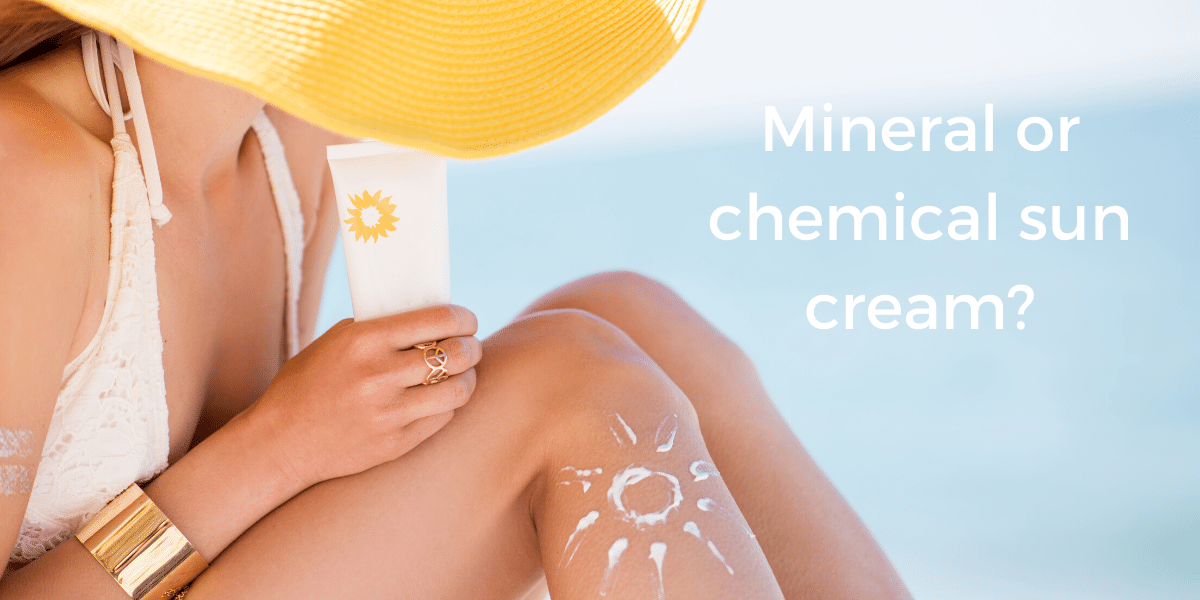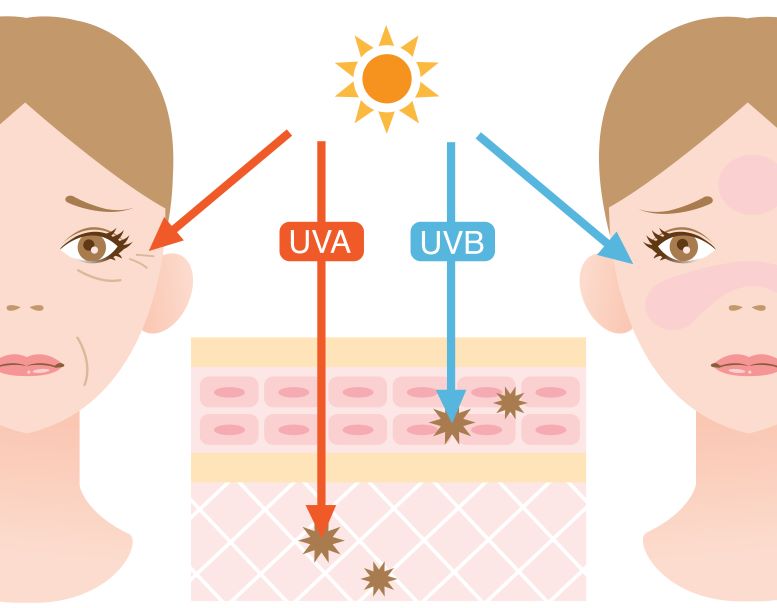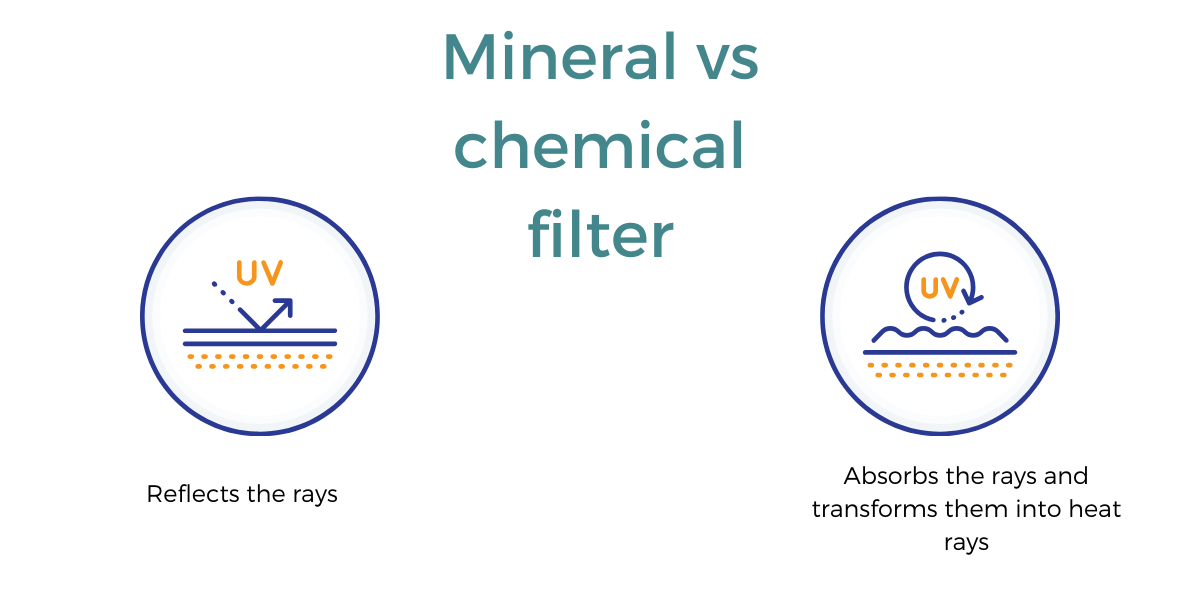Beauty Column Charlotte Vivien
Mineral vs chemical sun protection?

Credit Canva
Summer is almost here and you are wondering which sun cream would be best suited for you and your family and which one is the safest? It can be very tempting to look at a lovely packaging or delicious scent or even grab the one advertised at the till.
But it’s not as easy as that, it’s worth taking a few minutes to understand what you are applying on your skin.
What are the UV Rays?

Credit Shuterstock
UVA rays (A for ages the skin)
UVA activates melanin, a pigment that is already present on the surface of the skin. The melanin is what gives you a quick tan but also disappears extremely fast. In addition, UVA rays penetrate deeply into the layers of the skin where they have an effect on the connective tissue and blood vessels: the skin gradually loses its elasticity and begins to wrinkle. Significant exposure to UVA rays causes premature aging of the skin as well as creating free radicals that will in its turn modify the DNA of certain cells.
UVB rays (UVB = B for Burn)
UVB stimulates the production of new melanin, which leads to a massive increase in the quantities of dark pigment in a few days. This tan can last relatively long. UVB also stimulates cells to produce thicker skin. UVB is thus responsible for the browning and thickening of the surface layers of the skin – reactions which constitute the body’s defence mechanism against UV rays.
However, higher doses of UVB will cause sunburn, which increases the likelihood of getting cancer by as it affects the DNA of the cells that are damaged.
Sun protection is there to reduce the amount of UV rays that penetrate the skin
What is a chemical sun protection?
I think it is important to define what “chemical” is first as there are natural chemicals, “Water” is one “H2O” as you may remember in chemistry and then there are synthetic chemicals.
The chemical sun protection factors used by the cosmetics industry are synthetic. There are over 26 chemicals authorised in the EU.
The synthetic chemical filters
Chemical sun filters absorb the UV rays (UVA and UVB) and converts them into heat rays rather than the skin absorbing the UV rays. There are a variety of chemical synthetic filters used in the cosmetics industry, the most common being avobenzone, oxybenzone, octinoxate, and homosalate. Occasionally you may find more than one chemical filter within one product.
Pros:
- Most of these creams blend well into the skin without leaving any white residue on the surface of the skin
- Offers a good sun protection against UVA and UVB rays.
Cons:
- You need to wait 20-30min before exposure to the sun
- Can potentially disturb your endocrine system as well as affecting the coral reefs
- Some of the filters can cause allergies
- Is often associated with other problematic ingredients like parabens, Disodium EDTA etc. that can be potentially problematic to your health.
Chemical filters are not permitted in Organic certified products.
Mineral filters

Credit Canva
There are two main filters, titanium dioxide and zinc oxide, which act like a shield by reflecting the sun’s rays as soon as they come into contact with the skin. Both mineral filters offer protection against UVA and UVB rays.
You can find mineral filters in organic sun creams as well as the “regular” sun creams. In the regular creams they are sometimes in a “nano” form to reduce the “white film” it leaves on the skin. Sometimes the cosmetics companies blend both mineral and chemical sun protection factors within one cream.
To ensure you have the best possible sun protection opt for organic mineral sun cream. Sadly, they do also come with pros and cons.
Pros:
- Does not affect the coral reef
- Has no known risk on your health
- Offers a good protection for both adults and children
- Immediate protection as soon as cream is applied
Cons
- Tends to leave a white film especially the higher the SPF
- Harder to spread on the skin

Image par Pexels de Pixabay
Other than choosing the right cream for you, you must remember that no matter what cream you use, it won’t be a 100% protection. Here are my tips:
- It is best to avoid the peak hours of the day and stay in the shade
- Always wear a hat and sunglasses
- UV clothes for your children or even a dark colour t-shirt especially in the water
- Check your cream is certified organic (Ecocert, Cosmébio) to avoid any other unwanted ingredients in your sun cream
- Never attempt to make your own homemade sun cream
- Make sure that your cream has the appropriate UVA and UVB protection
- Reapply frequently
Enjoy the sunshine whilst looking after your skin, your health and the environment.
About the author:

Charlotte is specialist in organic dermo-cosmetics and Co-Founder of M&O Naturel. Formally she was a midwife. She is a bi national Swiss/ British citizen and lives in the French speaking part of Switzerland with her husband of Caribbean origins. Her skin-care creation was inspired by her son who suffered from eczema. After failing to find a suitable and natural product Charlotte decided to test various formulations using oils and butters. The eczema fully healed within 3 months. After this success she decided to retrain in organic cosmetic formulations. In 2014 she launched her own skincare range with co-founder and husband Dennis. The goal of M&O Naturel is to create products to help people achieve healthier skins using the best natural organic ingredients. www.monaturel.ch , www.moncosmetics.net (blog) www.instagram.com/monaturel

Fantastic article Charlotte thank you for sharing
Thank you. We are glad you liked the article.